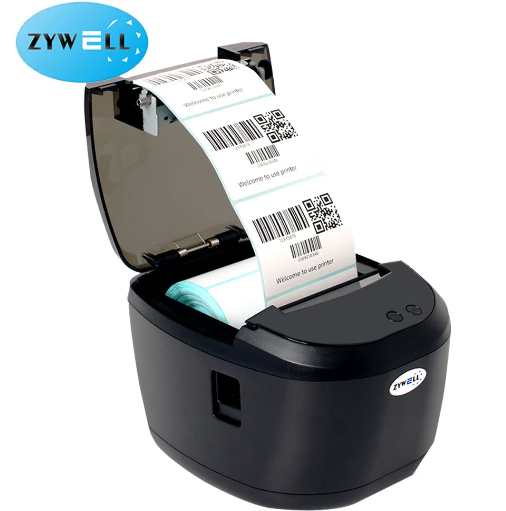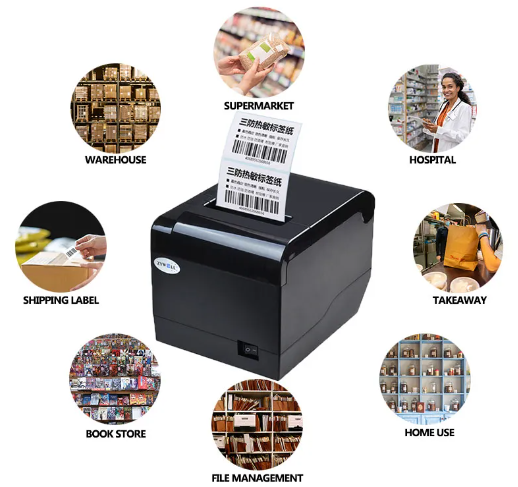How Does Thermal Label Printer Work - A Beginner Guide
Thermal printers are considered to be durable and dependable options compared to traditional inkjet printers.
Whether you own a restaurant, retail store, or run a hospital, printing receipts and labels is an integral part of all businesses.
Therefore you must know which type of printer is best to improve operational efficiencies and how it works. Thermal label printers are a reliable choice for all businesses.
This blog is focused on highlighting how thermal label makers work and how they act as a vital tool for all businesses.
What Is a Thermal Label Printer?
Thermal label printers work on the thermal process in which the printer employs heat to take printouts rather than ink.
Primarily, the purpose of this printer is to generate labels and signage on paper, ribbon, tape, or other materials.
Broadly, there are two types of thermal printing i.e., direct thermal and thermal transfer.
Direct Thermal Printing
Direct thermal printing is a process that generates a printed image by specifically heating the thermal paper that is itself heat-sensitive and chemically treated.
When the paper passes through the thermal print head then the coating of the heat-sensitive paper turns black across the areas where it is heated, thereby generating the relevant image.
However, the printouts generated through this process are more sensitive to light, heat, and abrasion, therefore, images fade over time when exposed to sunlight or heat. The tickets and cash register receipts are some common examples.
Thermal Transfer Printing
On the other hand, thermal transfer printing employs heated ribbons with ink to generate durable, smear-resistant, and long-lasting images. When heat is applied, it melts and embeds the ink across the media.
This is the reason that thermal transfer printing generates high-quality and durable images. Moreover, these printers do not require chemically treated media and can print on many materials, including paper, plastic, and polyester.
How Does a Thermal Label Printer Work?
Both categories of thermal label makers work differently on different principles. For example, direct thermal printing employs a special thermochromatic-coated paper which generates the image on heating.
Conversely, a thermal transfer printer operates via a printhead that heats the ribbon or paper. The printhead is composed of multiple small pins.
When the printer is turned on, the pins heat up and amount of the heat generated by each pin is determined by a computer.
The heat enables the paper or ribbon to alter its color and generates an image with varying levels of darkness. The paper or ribbon is loaded across the printer via a roller. After loading, the printhead moves across the paper or ribbon and generates the image that is transferred to the label.
What Are the Benefits of Using Thermal Label Printer?
Businesses can enjoy multiple benefits on preferring thermal label makers. Some of these benefits are highlighted below
They can ensure convenient, fastest, and quieter printing and, therefore are preferred across businesses requiring to generate printouts of many receipts daily
They are considered both time and cost-effective options for most businesses
They are generally low-maintenance, therefore, keeping them is a hassle-free task
Offers high-quality, clear, and precise images, reducing the possibility of any errors
The significant level of automation in generating multiple labels and receipts in no time improves operational efficiencies and enhances customer service
These printers are equally suitable for versatile applications. For instance, direct thermal printers are best suited for short-term purposes whereas thermal transfer printers are perfect for performing outdoor and industrial applications
What Are the Drawbacks of Using Thermal Label Printer?
Despite these benefits, thermal label printers also entail some drawbacks that are discussed below
The printouts created by direct thermal printers fade away with time or when exposed to sunlight or moisture
There are limited color palette options in thermal printing
Thermal transfer printing offers more durable and long-lasting images, however, it is expensive in some cases, thereby jeopardizing the printing quality if any of you have budget constraints.
In addition to cost, thermal transfer printers are a bit slower and require more maintenance in comparison to direct thermal printers
Which Type of Thermal Label Printer Is Right For You?
Are you confused about which type of label printer is most suitable for you? Then worry not, we have got you covered.
Before purchasing any label printer, you must first define your needs and priorities accurately as the choice of the printer entirely depends on your needs.
For instance, if you want to generate multiple labels and receipts, you should consider buying a direct thermal printer. Conversely, if you prefer durable and long-lasting labels, then a thermal transfer printer is the best choice for you.
No matter whether you want a direct or thermal transfer printer, Zywell is a reliable name in selling all types of thermal label makers.
With more than 20 years of experience and industry knowledge, the brand offers both types of label printers with an 18-month guarantee.
For more information, log on to Zywell.
Final Words
To conclude, thermal label makers are the most reliable tool for your office, restaurant, retail store, laboratory, medical facility, aircraft, or any other industrial place. These printers allow you to generate both receipts and labels conveniently and hassle-free.
Whether you want to take multiple copies of receipts or labels instantly or you prefer long-lasting labels, thermal label printers are the best choice to accomplish all printing needs.

Zhuhai zywell is a printer manufacturer and comprehensive high-tech enterprise integrating POS printer design, research and development, production, sales and service.
CONTACT DETAILS
If you have any question, please contact us.

















